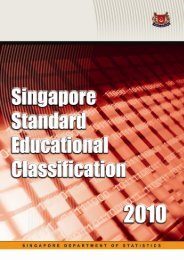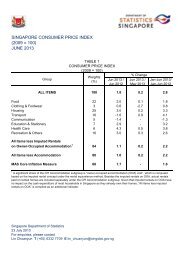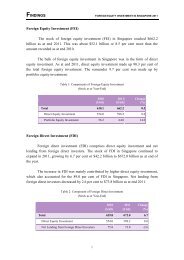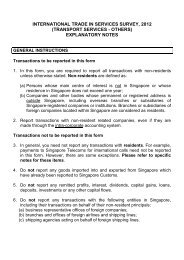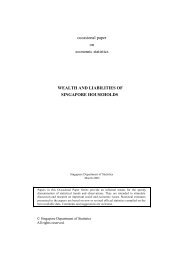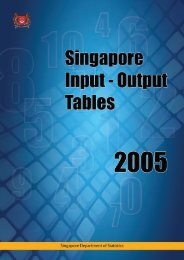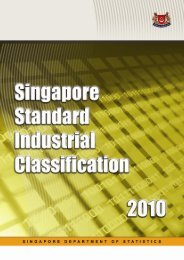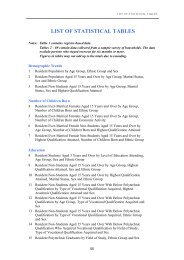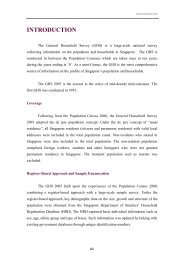Paper - Statistics Singapore
Paper - Statistics Singapore
Paper - Statistics Singapore
Create successful ePaper yourself
Turn your PDF publications into a flip-book with our unique Google optimized e-Paper software.
Conference on Chinese Population and Socioeconomic Studies:<br />
Utilizing the 2000/2001 round Census Data<br />
Hong Kong University of Science and Technology<br />
19-21 June 2002, Hong Kong SAR<br />
INTRODUCTION<br />
CHANGING EDUCATION PROFILE OF<br />
SINGAPORE POPULATION<br />
Over the last decade, significant gains have been made in <strong>Singapore</strong>’s<br />
economic and social development. One such area in which much progress has<br />
been made is in the education attainment of <strong>Singapore</strong>’s resident population.<br />
This paper provides an overview of the education profile of <strong>Singapore</strong><br />
residents. It highlights the changes in education attainment of <strong>Singapore</strong><br />
residents that have taken placed during the last decade and examines the extent<br />
of education upgrading among non-graduate residents. The paper also looks at<br />
how <strong>Singapore</strong>’s education profile compares with that of Hong Kong.<br />
Data are obtained from the latest round of <strong>Singapore</strong> Population Census<br />
conducted in 2000. Comparisons are made with the 1990 Population Census and<br />
1995 General Household Survey. Data for Hong Kong are drawn from Hong<br />
Kong 1991 and 2001 Population Censuses.<br />
HIGHEST QUALIFICATION ATTAINED<br />
The education profile of <strong>Singapore</strong> residents had improved significantly<br />
in the last decade. In 2000, some 57 per cent of the resident non-student<br />
population aged 15 years and over had secondary or higher qualifications<br />
(Table 1). This was 15 percentage points higher than the corresponding 42 per<br />
cent recorded in the 1990 census. The share of university graduates in the<br />
population had also increased significantly – from 4.5 per cent in 1990 to 12 per<br />
cent in 2000.
TABLE 1 HIGHEST QUALIFICATION ATTAINED<br />
Per Cent<br />
<strong>Singapore</strong><br />
Permanent<br />
Citizens<br />
Highest Qualification Attained<br />
Residents<br />
Residents<br />
1990 2000 1990 2000 1990 2000<br />
Total 100.0 100.0 100.0 100.0 100.0 100.0<br />
No Qualification 31.3 19.6 31.5 20.9 27.2 7.5<br />
Primary 27.0 23.1 26.8 23.6 30.9 17.6<br />
Secondary 26.5 24.6 27.0 25.3 16.7 18.5<br />
Upper Secondary 7.3 14.9 7.3 14.5 7.1 18.4<br />
Polytechnic 3.5 6.2 3.4 6.3 3.8 5.2<br />
University 4.5 11.7 4.0 9.5 14.2 32.7<br />
The improved educational attainment of the resident population reflected<br />
the expansion in educational facilities to meet the rising aspirations of the<br />
population to attain higher education. Thus, among <strong>Singapore</strong> citizens, 1 in 10<br />
had attained university qualifications in 2000 compared with 1 in 25 in 1990.<br />
The share of those with upper secondary or polytechnic qualifications also<br />
increased from 11 per cent in 1990 to 21 per cent in 2000.<br />
Another contributory factor was the increased inflow of well-educated<br />
permanent residents. Among the non-student permanent residents, 33 per cent<br />
were university graduates and another 24 per cent had post-secondary<br />
qualifications. The education profile of the permanent residents had improved<br />
markedly since 1990 when only 14 per cent were university graduates.<br />
Good Progress amongst All Ethnic Groups<br />
All ethnic groups among <strong>Singapore</strong> resident population had improved their<br />
education profile in the last ten years. The proportion with secondary or higher<br />
qualifications had increased from 43 per cent to 58 per cent among the Chinese,<br />
from 36 per cent to 50 per cent among the Malays and from 41 per cent to 62 per<br />
cent among the Indians (Table 2).
TABLE 2 HIGHEST QUALIFICATION ATTAINED BY ETHNIC GROUP<br />
Per Cent<br />
Highest Qualification Attained<br />
Chinese Malays Indians Others<br />
1990 2000 1990 2000 1990 2000 1990 2000<br />
Total 100.0 100.0 100.0 100.0 100.0 100.0 100.0 100.0<br />
No Qualification 32.0 20.2 30.5 20.0 27.7 13.9 15.5 7.5<br />
Primary 25.6 21.9 33.1 30.1 31.4 24.5 26.5 16.2<br />
Secondary 25.7 23.2 30.0 32.1 27.8 26.4 33.9 25.2<br />
Upper Secondary 7.6 15.0 4.9 12.9 7.7 15.6 12.2 19.9<br />
Polytechnic 4.1 7.0 0.9 2.9 1.2 3.1 2.3 3.8<br />
University 5.1 12.6 0.6 2.0 4.1 16.5 9.6 27.5<br />
In 2000, the Indians had the highest proportion of university graduates –<br />
17 per cent compared with 13 per cent for the Chinese and 2 per cent for the<br />
Malays. The Indians also had the largest increase in proportion of university<br />
graduates between 1990 and 2000 compared with the Chinese and Malays.<br />
The jump in the proportion of Indian university graduates was partly due to<br />
the entry of Indian permanent residents possessing university qualifications in the<br />
last decade. Among the population of Indian permanent residents, 51 per cent<br />
were university graduates in 2000, up from a mere 9.0 per cent in 1990 (Table 3).<br />
In contrast, the increase was smaller among the Chinese and Malay permanent<br />
residents.<br />
TABLE 3 PROPORTION OF RESIDENT UNIVERSITY GRADUATES<br />
BY ETHNIC GROUP AND RESIDENTIAL STATUS<br />
Per Cent<br />
<strong>Singapore</strong><br />
Permanent<br />
Citizens<br />
Ethnic Group<br />
Residents<br />
Residents<br />
1990 2000 1990 2000 1990 2000<br />
Total 4.5 11.7 4.0 9.5 14.2 32.7<br />
Chinese 5.1 12.6 4.6 10.8 16.3 29.7<br />
Malays 0.6 2.0 0.6 1.8 0.8 5.6<br />
Indians 4.1 16.5 3.6 8.1 9.0 51.0<br />
Others 9.6 27.5 5.3 11.0 31.9 51.1<br />
Well-Qualified Young Adults<br />
The majority of young <strong>Singapore</strong> residents had attained secondary or<br />
higher qualifications. In 2000, 82 per cent of residents aged 25–34 years had<br />
obtained at least secondary qualifications (Table 4). The proportions of<br />
polytechnic and university graduates among this group had improved
significantly over the decade – from 5 per cent to 11 per cent for polytechnic<br />
graduates and from 7 per cent to 24 per cent for university graduates.<br />
While the older adults were not as well-qualified as the younger ones, the<br />
proportions with at least secondary qualifications were still quite high – at 63 per<br />
cent amongst those aged 35–44 years and 47 per cent for those aged 45–54 years.<br />
However, relatively lower proportions of the older adults were polytechnic or<br />
university graduates.<br />
TABLE 4<br />
HIGHEST QUALIFICATION ATTAINED FOR AGE GROUPS 25–54 YEARS<br />
Highest Qualification Attained<br />
25–34 35–44 45–54<br />
Per Cent<br />
1990 2000 1990 2000 1990 2000<br />
Total 100.0 100.0 100.0 100.0 100.0 100.0<br />
No Qualification 12.2 4.3 23.9 9.7 49.7 19.8<br />
Primary 31.2 14.1 35.2 27.1 27.4 32.7<br />
Secondary 36.9 25.7 26.3 30.9 13.6 26.1<br />
Upper Secondary 7.6 20.6 7.0 15.1 4.6 12.5<br />
Polytechnic 4.9 10.9 2.4 4.7 1.2 2.1<br />
University 7.2 24.4 5.2 12.4 3.5 6.7<br />
Compared with 1990, all age groups had shown significant increases in the<br />
proportion with secondary or higher qualifications. The ageing of the bettereducated<br />
cohorts had helped improve the education profile of the older population.<br />
Parity in Educational Attainment between Younger Males and Females<br />
With equal education opportunities, younger females were as wellqualified<br />
as their male counterparts. In 2000, 81 per cent of females aged 25–34<br />
years and 62 per cent of those aged 35–44 years had at least secondary<br />
qualifications (Chart 1). The corresponding proportions for the males were 82<br />
per cent and 64 per cent. There was greater education disparity between males<br />
and females in the older age groups.
CHART 1 PROPORTION WITH AT LEAST SECONDARY EDUCATION, 2000<br />
Male<br />
Female<br />
Per Cent<br />
83.7 85.8<br />
82.2<br />
81.2<br />
64.2<br />
62.0<br />
52.8<br />
42.1<br />
27.8<br />
13.6<br />
15-24 25-34 35-44 45-54 55 & Over<br />
Age Group (Years)<br />
EDUCATIONAL UPGRADING<br />
More Non-Graduates Acquired Additional Qualifications<br />
Continuing education and upgrading through the attainment of technical,<br />
commercial and vocational qualifications at non-tertiary levels have become more<br />
prevalent. Among residents who were not university or polytechnic graduates in<br />
2000, 13 per cent had acquired technical, commercial or vocational qualifications<br />
after leaving school. This was higher than the corresponding proportion of 9.2 per<br />
cent in 1995. The increase was most marked for the prime working age groups<br />
between the ages of 25 and 39 years (Chart 2).<br />
CHART 2<br />
35<br />
30<br />
Per Cent<br />
PROPORTION WHO ACQUIRED TECHNICAL, COMMERCIAL<br />
OR VOCATIONAL QUALIFICATIONS<br />
25<br />
20<br />
15<br />
10<br />
5<br />
1995<br />
2000<br />
0<br />
15–19 20–24 25–29 30–34 35–39 40–44 45–49 50 & Over<br />
Age Group (Years)
Low Incidence of Educational Upgrading<br />
among the Older and Less Educated<br />
Older adults generally have lower propensity to upgrade their educational<br />
qualifications. Among the non-graduate residents aged 40 years and over in 2000,<br />
less than 15 per cent had acquired technical, commercial or vocational<br />
qualifications. In comparison, a much higher proportion of 30 per cent of those<br />
aged 25–29 years had upgraded themselves.<br />
Educational upgrading is less prevalent amongst those with below<br />
secondary qualifications. In 2000, only 9.4 per cent of those with primary<br />
qualifications and a mere 1.2 per cent of those with no qualifications had acquired<br />
technical, commercial or vocational qualifications (Table 5). Among the females,<br />
the proportion of those with less than secondary school education who sought<br />
further education was even lower.<br />
The likelihood of educational upgrading appears to be stronger amongst<br />
secondary school leavers. Among both the males and females with secondary and<br />
upper secondary qualifications in 2000, more than 20 per cent had acquired<br />
additional qualifications.<br />
TABLE 5<br />
PROPORTION WHO ACQUIRED ADDITIONAL QUALIFICATIONS<br />
BY HIGHEST ACADEMIC QUALIFICATION AND SEX<br />
Highest Academic Qualification<br />
Total Males Females<br />
Per Cent<br />
1995 2000 1995 2000 1995 2000<br />
Total 9.2 13.1 11.3 16.0 7.3 10.4<br />
No Qualification 0.6 1.2 1.2 2.5 0.2 0.5<br />
Primary 6.7 9.4 9.7 13.1 2.9 5.1<br />
Secondary 16.3 22.7 18.2 25.6 14.5 20.0<br />
Upper Secondary 17.3 22.7 14.6 21.6 19.8 23.7<br />
Majority of Less-Educated Obtained Basic Certificate<br />
The level of academic qualification is the main determinant of the type of<br />
technical, commercial or vocational qualification acquired after leaving school.<br />
Over 70 per cent of those with primary or no qualifications obtained a basic<br />
certificate such as the National Trade Certificate Grade 3 (NTC-3) or Certificate
of Competency (Table 6). In contrast, the majority of the secondary-educated<br />
obtained an advanced certificate, with a large group moving on to obtain<br />
diploma, advanced diploma or professional qualification.<br />
TABLE 6<br />
Type of Technical, Commercial<br />
or Vocational Qualification<br />
TYPE OF TECHNICAL, COMMERCIAL OR VOCATIONAL<br />
QUALIFICATION ACQUIRED BY HIGHEST ACADEMIC QUALIFICATION<br />
Per Cent<br />
No<br />
Upper<br />
Primary Secondary<br />
Qualification<br />
Secondary<br />
1995 2000 1995 2000 1995 2000 1995 2000<br />
Total 100.0 100.0 100.0 100.0 100.0 100.0 100.0 100.0<br />
Certificate 82.0 81.6 72.5 73.2 33.0 45.9 20.3 36.0<br />
Advanced Certificate 16.0 18.4 25.2 23.6 44.6 37.1 22.6 32.7<br />
Diploma / Advanced Diploma 1.0 - 1.5 1.4 16.5 10.6 40.5 20.7<br />
Professional Qualification 1.0 - 0.8 1.8 5.9 6.4 16.5 10.6<br />
Comparisons with Hong Kong<br />
Table 7 provides a comparison of the education profile of <strong>Singapore</strong> and<br />
Hong Kong. The education profile has improved in both cities during the 1990s.<br />
With <strong>Singapore</strong>’s emphasis on post-secondary education, the proportion with<br />
post-secondary qualifications has surged. Starting at the same base in 1990/1991,<br />
the share of the population with post-secondary education in <strong>Singapore</strong> is now<br />
higher than that of Hong Kong.<br />
TABLE 7 HIGHEST QUALIFICATION ATTAINED IN SINGAPORE AND HONG KONG<br />
Highest Qualification Attained<br />
<strong>Singapore</strong><br />
Total Population<br />
<strong>Singapore</strong><br />
Resident Population<br />
Per Cent<br />
Hong Kong<br />
Total Population<br />
1990 2000 1990 2000 1991 2001<br />
TOTAL 100.0 100.0 100.0 100.0 100.0 100.0<br />
Below Secondary 58.3 45.1 57.5 42.5 57.2 53.8<br />
Secondary 26.5 25.0 27.5 26.2 26.8 24.2<br />
Post Secondary 10.8 18.4 10.9 20.5 10.1 11.5<br />
University 4.4 11.6 4.1 10.8 5.9 10.5<br />
Notes :<br />
Data refer to persons aged 15 years and over. For <strong>Singapore</strong>, highest qualification attained refers to the highest<br />
standard passed or the highest level where a certificate, diploma or degree is awarded. Students’ highest qualification<br />
attained were imputed from their level of education attending. For Hong Kong, data refer to the highest level of<br />
education completed.<br />
Today, <strong>Singapore</strong> has a relatively larger graduate pool than Hong Kong.<br />
Of the total population in <strong>Singapore</strong> in 2000, 12 per cent were university<br />
graduates. Foreign talent inflows provided an important source for the increase in
university graduates. The corresponding proportion was lower in Hong Kong, at<br />
11 per cent in 2001.<br />
CONCLUSION<br />
<strong>Singapore</strong> residents have become better educated during the last decade.<br />
There are now proportionately more residents with upper secondary and<br />
university qualifications. Resident non-graduates have also developed a keen<br />
interest in education upgrading with more pursuing technical, commercial or<br />
vocational qualifications.<br />
Over the years, the education profile of <strong>Singapore</strong> residents is likely to<br />
improve as more opportunities are offered for education at tertiary level. There<br />
will be an increasing demand for education upgrading among resident nongraduates<br />
and even among graduates as more residents recognise the importance<br />
of continual upgrading to maintain and improve their employability and keep<br />
their knowledge and skills up to date and relevant.<br />
<strong>Singapore</strong> Department of <strong>Statistics</strong><br />
Jun 2002



